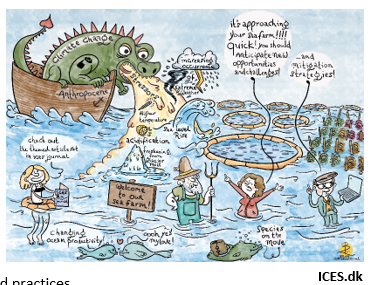ABIOTIC AND BIOTIC CHALLENGES FACING SALMON AQUACULTURE IN THE ERA OF CLIMATE CHANGE: UNDERSTANDING AND MANAGING INTERACTIVE EFFECTS THAT RESULT IN MORTALITY
Climate change is resulting in increases in average water temperatures and decreases in water oxygen levels (hypoxia), and more frequent and extreme weather events (i.e., storms, heat waves etc.). Given that salmon are predominantly reared in coastal marine sea-cages, this has led to a significant amount of research on the effects of high temperatures on the production, health and welfare of this species. However, recent research suggests that high temperatures (i.e., up to 20oC) and moderately low oxygen levels (e.g., down to 60-70% air saturation), by themselves, are unlikely to result in significant cage-site mortalities.
This was the impetus for us to take a comprehensive look at the abiotic and biotic factors that impact salmon at aquaculture cage-sites, their potential interaction with regard to causing mortalities, and management practices that might alleviate/mitigate, or exacerbate, the loss of fish under culture conditions. The model we have developed has many points of intersection/interaction, and includes factors such as algal blooms, nutrition, environmental variables, pathogens, the presence of ‘nuisance’ species (e.g., jellyfish), and management decisions and practices.
In this talk, I will provide some background information on the causes of salmon cage-site mortalities, and introduce an interactive model that details the interdependencies and causal relationships between the above and other factors. It is hoped that this model will: 1) improve our understanding of factors that influence salmon welfare and mortalities; 2) prove useful in mitigating these issues going forward; and 3) assist the industry and the research community in selecting directions/priorities for future R&D targeted at making salmon aquaculture more sustainable and profitable. In the future, we aim to transform this interactive model into a dynamic systems model that will predict the interaction between abiotic and biotic factors over time, and forewarn producers of conditions/events that might result in the loss of fish.
